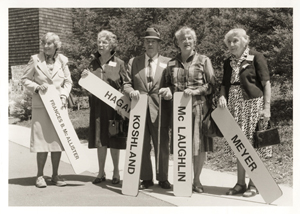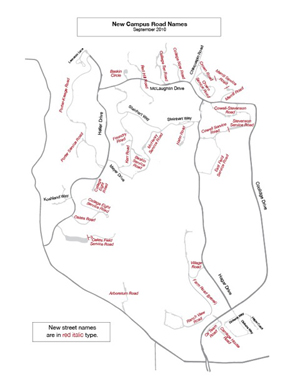UC Santa Cruz is renowned for its innovative approach to undergraduate education and its famously beautiful 2,000-acre campus on the former site of the Cowell Ranch. But when it came to getting around the sprawling campus, students, parents, and visitors alike were often bewildered.
That's because most of the streets were unnamed.
During almost all of UCSC's 45-year history, parents got lost, new students drove around in frantic circles, and people gave incomprehensible directions.
Not anymore. For the first time since its creation, UC Santa Cruz now has names for all of its roads, streets, and byways.
This begs the question: If UCSC is only naming its streets this year, how many of them were nameless before?
The truth is that a whopping 70 percent of all those roads had no names at all until this spring.
Three years ago, Susan Willats (College Five [now Porter], theater '81), assistant director of Transportation & Parking Services (TAPS), took an inventory of UCSC's roads--and discovered that most of those roads were completely anonymous. No names, no numbers, no nothing.
Asked about the reason for all those nameless roads, former campus architect Frank Zwart said, "My only guess--and it's pure speculation--was that no one found a need for them before now."
Zwart, who is recently retired, added that "UCSC was always a little bit like a medieval town. Knowing your way around was limited to the people who lived there."
No wonder all those people were staggering around campus with confused expressions on their faces. Dozens of intersections had no identifying signs of any kind. Stumped drivers whipped out their Blackberries and logged onto Mapquest and Google Earth, only to find that their "state-of-the-art" maps had blank spaces where names and waypoints were supposed to be.
To make matters even worse, online searches for various campus locations often direct visitors to "1156 High Street," the general mailing address for the campus. Never mind the fact that many UCSC landmarks are far, far away from 1156 High Street.
Willats worked with John Barnes, who is now currently the interim associate vice chancellor of Physical Planning and Construction, director of Transportation & Parking Services Larry Pageler, and fire chief Jeff Trapp to develop a list of potential road names.
Chancellor George Blumenthal approved the list of names, and the changes already appear on UCSC's online campus map.
UCSC has also alerted county emergency services about the changes.
But the campus still needs to alert the people over at Google--whose version of the UCSC map is not completely accurate, and includes none of the new names.
UC Santa Cruz's brand-new iPhone app utilizes Google’s map artwork. Willats is working to provide Google with the information they need, in the format they require, to correct their maps.
The campus also has to put up signs showing all those new names, and will replace existing signs with easier-to-read versions at the same time. This sign-building and replacement process will cost an estimated $22,000, according to Willats. She hopes the signs will be up by spring quarter 2011.
Willats, who also manages the online maps available at maps.ucsc.edu, added that the topography of the campus--which is built straight into the side of a mountain--added another layer of difficulty.
"Aside from the fact that there were so many nameless streets, the campus is densely forested," Willats said. "There is nary a straight road in the place. Everything is curvy and slope-y. It is fabulously beautiful because of that, but it makes way-finding complex."
The advent of road names could end a longstanding campus tradition of giving and receiving esoteric driving instructions to campus landmarks.
Take, for example, this actual set of directions that a UCSC student recently gave to someone trying to reach a campus destination:
"OK, so let's see, if you're starting out from the base of campus, take the western entrance, then head up past that first kiosk, follow it around, turn left at that second stop light, then go all the way up as far as you can go, so when you get to the tee-off, make a right, pass three colleges, and Science Hill, and then, once you get to the stop sign, it tees off again, and then you'll see the parking structure on the right, and then, at the stop sign, turn left at Northern Remote."
The new names could also spell doom for a second tradition--making up long, functional-but-clunky nicknames for roads that had no official names.
For instance, the road that is now known as "That Short, Wide Street that Leads Up to the Barn-Shaped Building Where Students Buy Parking Permits" will now be known simply as "Ox Team Road."
The new road names are mostly descriptive and informative, not honorific. Merrill Road is named for the college it passes, while Red Hill Road is merely the extension of an existing fire road. However, Ox Team Road is a reference to the campus's historic past as a lime-works operation.
The names of the new roads could be changed if members of an official campus-landmark naming committee decide to rename them after donors, Willats said, adding that the new names are "not immortal."
Willats has lots of experience finding her way around the place.
When she became in employee in 1986, she coordinated services for students with mobility impairments, including driving them around campus in a wheelchair lift-equipped van. Later she became one of the campus Americans with Disabilities Act (ADA) Compliance Officers, and eventually started the campus map program. Since March 2009, she has worked for TAPS.
Willats first came up with the idea for these wayfinding improvements 10 years ago when she was working on accessibility issues on campus.
"I noticed that a lot of people were getting lost, and that [mapmaking] didn't exist in anyone's job description," she said. "The only map of campus at the time was an 8-by-10-inch map that people saw at the back of the phone book."
She said that when people look back on the days of confusion and getting lost at UCSC, it could be a rueful, nostalgic memory, "like thinking about backpacking around Greece and being unable to read the alphabet."




